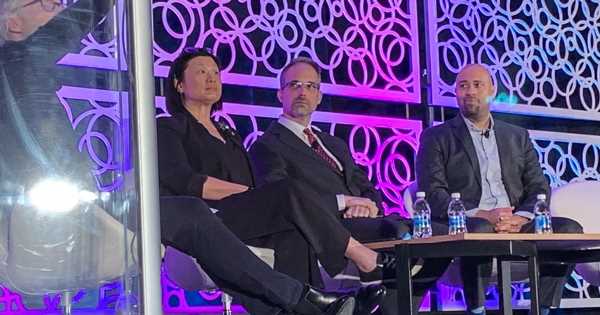Photo: HIMSS Media/Andrea Fox
Before introducing panelists from Kaiser Permanente, Intermountain Healthcare and Clalit Health Services to discuss how they have implemented artificial intelligence to improve their organizations, Tom Lawry, author and managing director of Second Century Technology, framed the conversation on the benefits of scaling AI by starting with its role in winning the pandemic.
“During the pandemic, many leaders – not all – were capable and willing to take on the status quo and were willing to drive true, active digital transformation,” said Lawry before a packed audience yesterday at the HIMSS23 ML and AI Forum.
“When we looked at what happened during the pandemic, we saw that humans fought and won the battle. But the weapon they chose…was AI.”
Though costly, AI can help healthcare move faster, he noted, and there is notable velocity to this change.
“If you are looking at the speed at which change was happening during the pandemic, I believe we are going to look back in a year from now and think that was going kind of slow.”
What are the impediments to driving AI’s value?
Healthcare faces many challenges despite the excellence of its workforce, said Lawry.
“I believe AI is big part of what we can be doing to change.”
“Many times when we’re looking at AI initiatives being deployed, it has a lot to do with things like process change and critical workflow improvements,” he said.
“And many times, in my view, when you look at where initiatives and organizations fail, it’s not because of the technical staff, it’s not because of the equipment.” To move healthcare forward, leaders are going to have to develop a new set of skills, he said.
Lawry cited Gartner on emerging C-Suite hard and soft skills – AI being the top emerging hard skill and design thinking the top emerging soft skill – which featured throughout the session.
Driving data-driven healthcare by design
Vivian Tan, vice president of strategic information management and global relationships at Kaiser Permanente, said the non-profit healthcare company’s AI’s focus is on supporting hospitals and clinicians with daily care delivery.
Kaiser’s Operations Watch mobile app, for example, provides real-time, location-specific data to support care delivery. Another AI tool that improves day-to-day operations alerts hospitals to deteriorating patient conditions, predicting when a patient might go to the ICU and preventing patient mortality by 16%, said Tan.
She said the healthcare company has a number of AI-driven tools that aim to streamline operations and improve patient care and is running 600 learning models, including deep learning models added during COVID-19.
Tan noted during a response to an attendee question about design thinking that the provider has user experience staff on all frontline projects, hiring its first UX/UI designer seven years ago.
Through an agile process, the development teams share wireframes every two weeks, she said.
“And any time it adds value, or doesn’t, we change things as we go. So, it’s very iterative.”
Preventive medicine catalyzes pandemic preparedness
Dr. Ran Balicer, chief innovation officer and deputy DG for Clalit Health Services – one of the largest health maintenance organizations in the world and Israel’s largest healthcare organization – said the provider has been digital and collecting data for more than 20 years.
“Our embedded interest is to keep the patients healthy,” because the nation incentivizes preventive medicine, he said.
When Lawry asked why the healthcare system in Israel was “ahead of the curve” at the onset of the pandemic, Balicer replied it was because they already had predictive data at scale to react instantly to the crisis.
For example, through Israel’s early warning system, the country notified the 200,000 patients Clalit’s predictive models had identified in its population as the highest risk for COVID by March 2020. They immediately shifted those patients to virtual care, which Balicer said helped control the country’s infection rates and mortalities.
“When you take a look at the outcomes of that first wave you can see that Israel had one of the lowest impacts globally,” he said.
A data-driven healthcare system, Clalit is also moving from individual projects toward a systematic change.
“We are trying to transform the operational part of what we do from the old paradigm, which is reactive, intuitive care, to something that is much more proactive, predictive driven by decision support,” and it’s all happening through its extensive data.
Frontline focus, explainability and AI fabrications
Albert Marinez, chief analytics officer at Intermountain Healthcare, said the provider is focused on how people can live the healthiest lives possible and stay out of the high-cost care areas.
A lot of the work around AI is on “how do we change the operational architecture of how we do the work?…and applying those concepts to use cases to drive value and do it again, again and again,” said Marinez.
He emphasized equipping physicians as a priority – they say they have a lot of data “but we’re hungry for information.”
Marinez said to scale AI, Intermountain is focused on how to empower doctors “with the actual data analytics that are necessary to discover new strategies, and then help them actually implement them into the workflows.”
Intermountain also uses AI to better understand patient flows and to discover where discharge barriers are to get ahead of them.
“It’s a huge opportunity, we are actually piloting that right now,” he said, noting that it has a $15-$20 million potential savings for the organization.
In response to a question about AI machines “fabricating” information, digital leaders need to get better at the explanation piece.
“Too much of AI does feel like it combines thoughts. The technology is progressing, though, to be able to have more and better information on why the algorithm arrived at the conclusion that it did,” Marinez said.
Andrea Fox is senior editor of Healthcare IT News.
Email: [email protected]
Healthcare IT News is a HIMSS Media publication.
Source: Read Full Article
